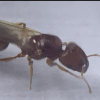1. Location (on a map) of collection: Belgium, Overijse.
2. Date of collection: 2nd of June
3. Habitat of collection: Parking lot (was living on a side habitat with Ivy, grass and earth.
4. Length (from head to gaster): About 9mm
5. Color, hue, pattern and texture: Brownish, can't recognise pattens, some dented stripes without color change.
6. Distinguishing characteristics: alongated gaster that ends in an abrupt spike
7. Distinguishing behavior: none noted
8. Nest description: no idea
9. Nuptial flight time and date: no idea



Sent from my SM-N986B using Tapatalk
Edited by Just.J, June 2 2021 - 12:49 PM.

























